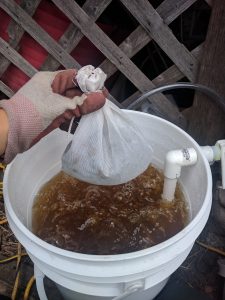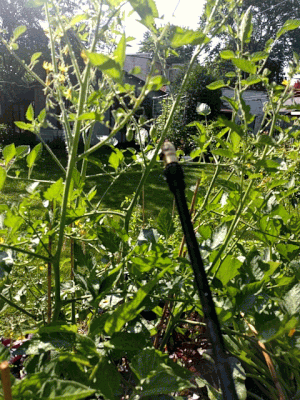Throw your Garden a Compost Tea Party
This summer we’re experimenting with brewing compost tea for our plants. In a nutshell, compost tea is a concoction of compost diluted in aerated water. This was something we learned about while taking the Organic Master Gardener‘s course at Gaia College and its potential to augment soil and plant health has been demonstrated by Dr. Elaine Ingham.
Most home gardeners (and even farmers) don’t make enough compost for their gardens/farms. Compost tea is all about stretching the benefits from the compost we have as far as possible by breeding the beneficial microbes in the compost. To do this we need to create the right environment for the microbes to thrive. It involves 4 basic components:
- Microbes
- Water
- Food
- Air
1. Microbes in Compost

The most important component of compost tea is the compost! You’ll need a small sample of your best compost. Compost tea will only ever be as beneficial (or detrimental!) as the bacteria we’re breeding so make sure you use the BEST compost possible as brewing compost tea may potentially multiply bad bacteria. As much as we advocate the use of beneficial bacteria and fungi in our gardens, don’t forget that our contemporary addiction to sterility and antibiotics comes from a history of human exposure to bad microbes (plagues, infections and disease)!
It’s best to use homemade compost to ensure that you’re propagating beneficial bacteria that already thrive in your specific environment. However, if you’re unsure about the quality of your own compost, you can try to use quality-assured store-bought compost like Jocelyn’s Soil Booster (worm castings).
2. Dechlorinated water
Water is used as a medium to host the bacteria. Rain water is fine to use at is, but tap water will be chlorinated. Our municipalities chlorinate our water to disinfect it from bad microbes, however it also kills the good guys… needless to say, chlorine could render our entire project useless!
To dechlorinate water, you first have to figure out whether your municipality uses chlorine or chloramine. The former can simply be removed by aerating the water for 24 hours prior to adding the compost. The latter is slightly too strongly bound to be off gassed. Instead chloramine can be neutralized immediately with vitamin C power. In Toronto, we have chloramine in our water.
3. Microbe Food
Microbes need food too. We can feed them a mixture of any combination of liquid kelp, molasses, sea minerals, and liquid fish. But don’t overdo it, or the brew can go anaerobic.
4. Air
Finally, we need to encourage the good aerobic bacteria to reproduce and kills off any bad anaerobic bacteria. We do this by providing the environment for the former to thrive and the latter to die by aerating the mixture. This is typically done with some sort of pump … the brewing process will essentially by an aerobic bacteria Jacuzzi!
For the same reasons as above, it’s best to brew your compost tea outside as opposed to indoors to ensure that you are propagating beneficial bacteria that thrive in the temperature you’ll be using the compost tea in.
Recipes
There are tons of recipes out there each with a slightly different ratio of the 4 aforementioned components. This is the one we’re using right now:
- 5 gallons of water (dechlorinated with a sprinkle of vitamin C powder)
- 2 cups of vermicompost
- 1 tbsp liquid kelp
- 1 tbsp molasses
- 1 tsp sea minerals
Timing
We aerate the mixture for 24 hours and spray the mixture on the leaves of our plants before 10am in the morning while the plant’s stomata are still open. There are diminishing returns when the mixture is aerated for more than 24 hours as the bacteria may be saturated and run out of food. The tea must be used within 2-5 hours of ending the aeration process as we’ve artificially induced the reproduction of the aerobic bacteria to a much higher concentration than what could occur naturally. When we stop providing their preferred environment (via aeration), they will die off quite quickly.
 Tea is ready. Guests are ready. |
 …IT’S TEA PARTY TIME!! |
| Is it compost tea or is it a cesspool??? …Only a microscope can tell! |
Spraying
Compost tea can be applied to soil or folliarly (on the leaves) on plants. At the BUFCO Lab, we’re experimenting with foliar applications for disease prevention and potentially reversal. For example, we’re trying to prevent and reverse early signs of powdery mildew on our zucchini and tomatoes.
The idea is to coat the plants with beneficial aerobic bacteria that will colonize on the plants and out compete and crowd out the bad guys. That said, be careful to spray both the tops and undersides of the leaves.
Stay tuned for the results of our little experiment!
Despite all this theory, it’s ultimately impossible to know whether the compost tea will be beneficial or not unless we have a microscope to see what kinds of bacteria and nematodes are present. So yes, we’ve been naively spraying our plants with Who-Knows-What. But fret not, for we’re making plans to get our hands on a microscope and we’re soooo excited to share what we’ll see!